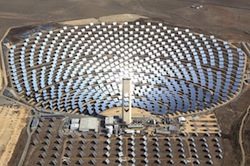Abengoa has been selected by the Ministry of Energy of the Chilean Government and Corfo (Corporacion de Fomento de la Produccion) to develop a 110 MW solar plant using tower technology with 17.5 hours of thermal energy storage using molten salts. The project will be located in the Atacama Desert, the region, believed to have the highest solar radiation concentrations in the world. It will be the first solar-thermal plant for direct electricity production in South America.
 Abengoa’s project won the international tender launched by the Chilean Ministry of Energy and Corfo to construct the first Concentrated Solar Power plant in Latin America. As part of this tender, the project will receive direct subsidies from the Chilean Government and the European Union, as well as financing from the Inter-American Development Bank, KFW Kreditanstalt fur Wiederaufbau, the Clean Technology Fund and Canadian Fund.
Abengoa’s project won the international tender launched by the Chilean Ministry of Energy and Corfo to construct the first Concentrated Solar Power plant in Latin America. As part of this tender, the project will receive direct subsidies from the Chilean Government and the European Union, as well as financing from the Inter-American Development Bank, KFW Kreditanstalt fur Wiederaufbau, the Clean Technology Fund and Canadian Fund.
Solar-thermal tower technology uses a series of mirrors (heliostats) that track the sun on two axes, concentrating the solar radiation on a receiver on the upper part of the tower where the heat is transferred to the molten salts. The salts then transfer their heat in a heat exchanger to a water current to generate superheated and reheated steam, which feeds a turbine capable of generating around 110 MW of power.
The solar plant will also have a pioneering thermal storage system with 17.5 hours of storage that has been designed and developed by Abengoa. The company explains this approach makes the technology highly manageable, enabling it to supply electricity in a stable way, 24 hours a day, responding to all periods of electricity demand.
Abengoa’s new project will be located in the commune of Maria Elena in the Antofagasta region, northern Chile. The project forms part of Chile’s national renewable energy program, intended to provide Chile with a cleaner energy future, while also promoting its economic development and reducing its dependency on coal and natural gas. Chile has set a target to produce 20% of its electricity from clean energy sources by 2025.
Construction of the project is due to start in the second half of 2014.

